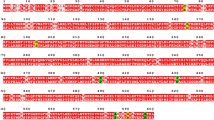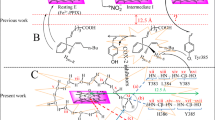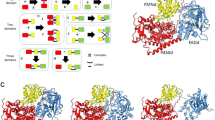Abstract
The first crystal structure of human cyclooxygenase-2, in the presence of a selective inhibitor, is similar to that of cyclooxygenase-1. The structure of the NSAID binding site is also well conserved, although there are differences in its overall size and shape which may be exploited for the further development of selective COX-2 inhibitors. A second COX-2 structure with a different bound inhibitor displays a new, open conformation at the bottom of the NSAID binding site, without significant changes in other regions of the COX-2 structure. These two COX-2 structures provide evidence for the flexible nature of cyclooxygenase, revealing details about how substrate and inhibitor may gain access to the cyclooxygenase active site from within the membrane.
This is a preview of subscription content, access via your institution
Access options
Subscribe to this journal
Receive 12 print issues and online access
$189.00 per year
only $15.75 per issue
Buy this article
- Purchase on Springer Link
- Instant access to full article PDF
Prices may be subject to local taxes which are calculated during checkout
Similar content being viewed by others
References
Goetzl, E.J., An, S. & Smith, W.L. Specificty of expression and effects of eicosanoid mediators in normal physiology and human diseases. FASEB J. 9, 1051–1058 (1995).
Smith, W.L., Borgeat, P. & Fitzpatrick, F.A. The eicosanoids: cydoxygenase, lipoxygenase, and epoxygenase pathways. in Biochemistry of Lipids, Lipoproteins and Membranes (eds. D.E. Vance and J. Vance) 297–325 (Elesvier Science Publishers, 1991).
Kujubu, D.A., Fletcher, B.S., Varnum, B.C., Lim, R.W. & Herschman, H.R. TIS10, a phorbol ester tumor promoter-inducible mRNA from Swiss 3T3 cells, encodes a novel prostaglandin synthase/cyclooxygenase. J. Biol. Chem. 266, 12866–12872 (1991).
Hla, T. & Neilson, K. Human cyclooxygenase-2 cDNA. Proc. Natl. Acad. Sci., USA 89, 7384–7388 (1992).
Tazawa, R., Xu, X.M., Wu, K.K. & Wang, L.H. Characterization of the genomic structure, chromosomal location and promoter of human prostaglandin H synthase-2 gene. Biochem. Biophys. Res. Comm. 203, 190–199 (1994).
Goppelt-Struebe, M. Regulation of Prostaglandin endoperoxide synthase (Cyclooxygenase) isozyme expression. Prostagl. Leukotr. Essen. Fatty Acids 52, 213–222 (1995).
Morita, I. et al. Different intracellular locations for prostaglandin endoperoxide H synthase-1 and -2. J. Biol. Chem. 270, 10902–10908 (1995).
Lassmann, G., Odenwaller, R., Curtis, J.F., DeGray, J.A., Mason, R.P., Marnett, L.J. & Eling, T.E. Electron spin resonance investigation of tyrosyl radicals of prostaglandin H synthase: Relation to enzyme catalysis. J. Biol. Chem. 266, 20045–2055 (1991).
Shimokawa, T., Kulmacz, R.J., Dewitt, D.L. & Smith, W.L. Tyrosine 385 of prostaglandin endoperoxide synthase is required for cyclooxygenase catalysis. J. Biol. Chem. 265, 20073–20076 (1990).
Picot, D., Loll, P.J. & Garavito, R.M. The X-ray crystal structure of the membrane protein prostaglandin H2 synthase-1. Nature 367, 243–249 (1994).
Smith, W.L., Eling, T.E., Kulmacz, R.J., Marnett, L.J. & Tsai, A. Tyrosyl radicals and their role in hydroperoxide dependent activation and inactivation of prostaglandin endoperoxide synthase. Biochem. 31, 3–7 (1992).
Copeland, R.A. et al. Mechanism of selective inhibition of the inducible isoform of prostaglandin G/H synthase. Proc. Natl. Acad. Sci. USA 91, 11202–11206 (1994).
Garavito, R.M. Crystallizing membrane proteins: Experiments on different systems. in Crystallization of Membrane Proteins (eds. H. Michel) 89–105 (CRC Press, Boca Raton, 1991).
Barnett, J. et al. Purification, characterization and selective inhibition of human prostaglandin G/H synthase 1 and 2 expressed in the baculovirus system. Bioch. Biophys. Acata 1209, 130–139 (1994).
Hope, H. Crystallography of biological macromolecules at ultra-low temperature. Annu. Rev. Biophys. Biophys. Chem. 19, 107–126 (1990).
Abola, E.E., Berstein, F.C., Bryant, S.H., Koetzle, T.F. & Weng, J. Protein Data Bank. in Crystallographk Databases - Information Content, Software Systems, Scientific Applications. (eds F.H. Alien, G. Bergerhoff & R. Sievers) 107–132 (Data Commission of the International Union of Crystallography, Bonn, 1987).
Masferrer, J.L. et al. Selective inhibition of inducible cyclooxygenase 2 in vivo is antiinflammatory and nonulecerogenic. Proc. Natl. Acad Sci., USA 91, 3228–3232 (1994).
Garavito, R.M., Picot, D. & Loll, P.J. The 3.1 Å X-ray crystal structure of the integral membrane enzyme prostaglandin H2 synthase-1. Adv. Prostagl. Throm. Leukotr. Res. 23, 99–103 (1995).
Luzzati, V. Treatment of statistical errors in the determination of crystal structures. Acta Crystallogr. 5, 802–810 (1952).
Loll, P.J., Picot, D., Ekabo, O. & Garavito, R.M. Synthesis and use of iodinated nonsteroidal antiinflammatory drug analogs as crystallographic probes of the the prostaglandin H2 cyclooxygenase active site. Biochem. 35, 7330–7340 (1996).
Loll, P.J., Picot, D. & Garavito, R.M. The structural basis of aspirin activity inferred from the crystal structure of inactivated prostaglandin H2 synthase. Nature Struct. Biol. 2, 637–642 (1995).
Callan, O.H., So, O. & Swinney, D. The kinetic factors that determine the affinity and selectivity for slow binding inhibition of human prostaglandin H synthase 1 and 2 by indomethicin and flurbiprofen. J. Biol.Chem. 271, 3548–3554 (1996).
Nicholls, A., Sharp, K. & Honig, B. Protein folding and association: insights from the interfacial and thermodynamic properties of hydrocarbons. Proteins 11, 281–296 (1991).
Gierse, J.K. et al. A single amino acid difference between cyclooxygenase-1 (COX-1) and -2 (COX-2) reverses the selectivity of COX-2 specific inhibitors. J. Biol. Chem. 271, 15810–15814 (1996).
Laneuville, O. et al. Fatty acid substrate specificites of human prostaglandin-enderoxide H synthase-1 and -2. J. Biol. Chem. 270, 19330–19336 (1995).
Vane, J.R. Inhibition of prostaglandin synthesis as a mechanism of action for aspirin-like drugs. Nature New Biol. 231, 232–235 (1971).
DeWitt, D.L. et al. The aspirin and heme-binding sites of ovine and murine prostaglandin endoperoxide synthases. J. Biol. Chem. 1990, 5192–5198 (1990).
Lecomte, M., Laneuville, O., Ji, C., DeWitt, D.L. & Smith, W.L. Acetylation of human prostaglandin endoperoxide synthase-2 (cyclooxygenase-2) by aspirin. J. Biol. Chem. 269, 13207–13215 (1994).
Mancini, J.A., O'eill, G.P., Bayly, C. & Vickers, P.J. Mutation of serine-516 in human prostaglandin G/H synthase-2 to methionine and aspirin acetylation of this residue stimulates 15-R-HETE synthesis. FEBS Lett. 342, 33–37 (1994).
McPherson, A. Preparation and analysis of protein crystals. (John Wiley & Sons, New York, 1982).
Otwinowski, Z. Oscillation data reductions program. in Proc. CCP4 Study Weekend, 29-30 Jan 1991. Data collection and processing (eds. L. Sawyer, N. Isaacs and S. Bailey) 55–62 SERC Daresbury Laboratory, UK, 1993).
The CCP4 suite: Programs for protein crystallography. Acta Cryst. D50, 760–763 (1994).
Brünger, A.T. X-PLOR: Version 3.1 (Yale Press, New Haven, 1987).
Bernstein, F.C. et al. The protein data bank: A computer-based archival file for macromolecular structures. J. Mol. Biol. 112, 535–542 (1977).
Brünger, A.T. Extension of molecular replacment:. A new search strategy based on Patterson correlation refinement. Acta Crystallogr. A45, 46–57 (1990).
Brünger, A.T. The free R value: a novel statistical quantity for assessing the accuracy of crystal structures. Nature 355, 472–474 (1992).
Muller, K. et al. MOLOC: A molecular modeling program. Bull. Soc. Chim. Belg. 97, 655–667 (1988).
Browner, M.F., Fauman, E.B. & Fletterick, R.J. Tracking conformational states in allosteric transitions of phosphorylase. Biochemistry 31, 11297–11304 (1992).
Kraulis, P. MOLSCRIPT: a program to produce both detailed and schematic plots of protein structures. J. App. Crystallgr. 24, 946–950 (1991).
Bacon, D.J. & Anderson, W.F. A fast algorithm for rendering space-filling molecule pictures. J. Molec. Graph. 6, 219–220 (1988).
Author information
Authors and Affiliations
Rights and permissions
About this article
Cite this article
Luong, C., Miller, A., Barnett, J. et al. Flexibility of the NSAID binding site in the structure of human cyclooxygenase-2. Nat Struct Mol Biol 3, 927–933 (1996). https://doi.org/10.1038/nsb1196-927
Received:
Accepted:
Issue Date:
DOI: https://doi.org/10.1038/nsb1196-927
This article is cited by
-
Discovery of Bis-sydnone styryl ketone as a selective cyclooxygenase-2 inhibitor
Future Journal of Pharmaceutical Sciences (2021)
-
C-phycocyanin: a natural product with radiosensitizing property for enhancement of colon cancer radiation therapy efficacy through inhibition of COX-2 expression
Scientific Reports (2019)
-
Interplay between adenosine receptor antagonist and cyclooxygenase inhibitor in haloperidol-induced extrapyramidal effects in mice
Metabolic Brain Disease (2018)
-
In situ click chemistry generation of cyclooxygenase-2 inhibitors
Nature Communications (2017)
-
Biological activity evaluation and molecular docking study of chromone derivatives as cyclooxygenase-2 inhibitors
Medicinal Chemistry Research (2017)



